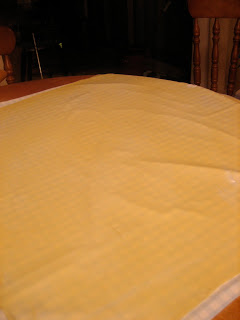Strudel is also a classic in the German speaking part of Italy, in Trentino Alto Adige.
I really like the strudel dough. I discovered that a lot of people are intimidated by this dough. When I was living in NY I was giving cooking classes to my collegues, I realized that the most of them had problems with it. They were too rigid. This dough is something to play around, it's really fun. It works great also for many savory strudels.
I use
150 g of flour 00 (or low protein)
half of a beaten egg
30 g of butter (or oil if you prefer)
a pinch of salt
a pinch of sugar
a couple drops of vinegar (to break down the gluten and make easier the rolling)
and enough warm water to get a soft dough (not sticky)
Make a hole in the flour, work with a fork the soft butter and the egg, salt and sugar, add the water a little by little, when a rough dough is done add just the water necessary to work together the flour on the sides. Then you need to work the dough vigorously, slamming and beating it on the pasta board. It should feel soft, silky but not sticky.
Like this

I cover the dough with a bowl and go on preparing the apples. This time I measured the weight of the final dough, was 250 grams.
For the filling:
4 big apples (I prefer using unripe golden, but a lot of people like the more sour cooking kind of apples)
breadcrumbs
butter to toast the crumbs+extra to brush the strudel, sorry I didn't measure it, for sure about more than one stick of butter, more than 100 grams
cinnamon
pine nuts (I add also walnuts because I like it)
lemon zest
raisins
sugar
I peel the apple, rub with a lemon and slice thin.
Toast some breadcrumbs with butter (maybe 50 grams of breadcrumbs more or less) and prepare some melted butter for brushing.
Now starts the fun part. The dough needs to rest for at least half an hour.
I take a pretty big towel, or a small tablecloth, dust with flour and start rolling the dough with the rolling pin. The dough is very easy to roll, it makes less resistance than a pasta dough. Only when you feel the dough is very thin and you cannot achieve much more with the rolling pin you can switch to your hands

Close your fists and gently, really gently start stretching the dough. If it was worked properly you will not have any problem with it! Rotate the dough and keep working all of it.
You will end up with something like this. It should be almost transparent. In any case, with a sharp knife I cut of the hedges of the dough, it is invitable that they are a little thicker than the center.

Brush the dough with melted butter, sprinkle with the toasted breadcrumbs, cover the 2/3 of it with apples, sprinkle with nuts, raisins and dust with cinnamon. If your apples are particularly sour you can sprinkle also some sugar on top, 4-5 tablespoons, I usually omit it. I fold slightly the shorter sides on the filling (about 3 cm) and then I start rolling the strudel on the long side closer to me with the help of the towel

When the strudel has been rolled, it should be at the top tip of the kitchen towel, that makes it easier to drop the strudel on a sheet pan. Make sure you have one buttered sheet pan already prepared. The pinch should be at the bottom of the strudel and try to give to it a horse shoes shape, it look nicer and it will fit also a smaller sheet pan.
Brush generously with melted butter and bake in a preheated oven at 200 Celsius for about 35 minutes or until nice an golden.
Dust with 10X sugar and serve with an emulsified whipping cream or with a creme anglaise or even plain.











